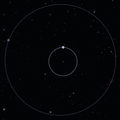Kerbin/da
"Kerbin" er Kerbalernes hjemplanet og stedet hvor Kerbal Space Centeret står. Den svarer til virkelighedens Jord, og har to måner Mun og Minmus.
Kerbin er den tredjestørste planet i kredsløb om stjernen Kerbol. Det er den tredjestørste planet (de to største er Jool og Eve), og er det fjerdestørste himmellegeme om Kerbol (Tylo, en af Jools måner, er en smule større).
At nå et stabilt kredsløb om Kerbin er en af de første målepæle en spiller kan nå i spillet. At opnå et sådant kredsløb med en brændsstofoptimal opstigning[1] kræver en delta-v på omkring 4.500 m/s, næst mest af alle himmellegemerne med en fast overflade efter planeten Eve. For langt de fleste interplanetare missioner gælder det, at over halvdelen af missionens samlede delta-V bruges til opnåelse af kredsløb om Kerbin. Det samme afspejler sig i virkelige interplanetare rummissioner, hvilket har ført en til at sige:
| » | If you can get your ship into orbit, you're halfway to anywhere. — Robert Heinlein, quoted on page 194 of A Step Farther Out by Jerry Pournelle |
« |
Contents
Topography
Kerbin has a roughly equal distribution of surface liquid water and solid land, with polar icecaps and scattered deserts. There are mountains exceeding 4 km in height, with the tallest peak being just under 4044 m in altitude.
Kerbin shows signs of having been impacted by an asteroid or comet. That is visible in the large crater in the western hemisphere. The crater's central peak is visible from orbit and was caused by the compression followed by the rebound of material in the center of the crater.
Atmosphere
Kerbin's atmosphere contains oxygen and extends to roughly 69,078 meters. Its atmosphere becomes exponentially less dense as altitude increases (with a scale height of 5 km).[2] In general, the atmospheric pressure on Kerbin, at an altitude expressed in meters, is:
The thickness of Kerbin's atmosphere makes it suitable for aerobraking and using parachutes, useful for saving on fuel when spacecraft return to Kerbin. Note that debris is not affected by air resistance above approximately 10 km, so spent stages may continue in a stable orbit even if they are going through thick atmosphere that would stop an active craft (0.19). Crafts will experience re entry and supersonic air effects as of 0.19. This however will not damage or burn it.
The following table gives approximation of terminal velocities at different Kerbin altitudes. These are also the velocities at which a ship should travel for a fuel-optimal ascent from Kerbin, given the game's model of atmospheric drag (0.18.1).[3]
| Altitude (m) | Velocity (m/s) |
|---|---|
| 0 | 97.3 |
| 1000 | 110 |
| 3000 | 130 |
| 5000 | 160 |
| 8000 | 215 |
| 10000 | 260 |
| 15000 | 425 |
| 32000 | 2250 |
Orbits
Geosynchronous orbit is achieved at an altitude of 2 863,33 km and a speed of 1 009,81 m/s. From a 70 km low equatorial orbit, the periapsis maneuver requires 676.5 m/s and the apoapsis maneuver requires 434.9 m/s. A semi-synchronous orbit with an orbital period of 1/2 of Kerbin's rotation period (3 hours or 10800 seconds) is achieved at an altitude of 1 581,76 km with an orbital velocity of 1 272,28 m/s.
The Hill Sphere (the radius around the planet at which moons are gravitationally stable) of Kerbin is 136 185km, or roughly 227 Kerbin radii.
Interplanetary Travel
From the lowest stable orbit around Kerbin (70 km), the amount of delta-V needed to reach the orbits of other celestials is as follows:
| Body | Delta-V | |
|---|---|---|
| Mün | ~860 m/s | |
| Minmus | ~930 m/s | |
| Eve | ~1033 m/s | |
| Duna | ~1060 m/s | |
| Moho | ~1676 m/s | |
| Jool | ~1915 m/s | |
| Eeloo | ~2100 m/s | |
| KEO (comparison) | ~1120 m/s | |
Reference Frames
| Time warp | Minimum Altitude |
|---|---|
| 1× | Any |
| 5× | 70 000 m (above the atmosphere) |
| 10× | 70 000 m (above the atmosphere) |
| 50× | 70 000 m (above the atmosphere) |
| 100× | 120 000 m |
| 1 000× | 240 000 m |
| 10 000× | 480 000 m |
| 100 000× | 600 000 m |
Gallery
- NJ6qJ.jpg
A projection map of Kerbin, as of 0.14.1 and before (including the old demo).
Topographical image of Kerbin from 0.17.1. The terrain is slightly different in the latest version.[4]
Changes
- Fixed ladders on the fuel tanks near the launchpad.
- New mesh for the launchpad and area (no launchtower anymore).
- New mesh for the runway, with lights and sloping edges for rovers.
- Terrain overhaul: Entire planet redo. Deserts, darker and greener grass, islands, darker ocean/water, snow capped mountains. Looks more realistic.
- Several Easter Eggs added.
- Airport added to island off of KSC coastline. (Not a launching point)
- Improved atmosphere visuals.
- Minmus added.
- Much more varied and taller terrain added. Prior to this, some mountain ranges exceeded 600 m in height, but the tallest point was at an altitude of approximately 900 m.
- Mün added.
- Terrain overhaul, oceans became wet.
- Atmosphere extended from ~34,500 m to ~69,000 m.
- Initial Release
Trivia
Kerbin's continents are derived from libnoise [5], though they have been increasingly modified with time.
Notes
- ↑ En brændstofoptimal opstigning er en som (a) minimerer hastigheds tab grundet tyngdekraft og atmosfære, og (b) affyres mod øst for at få 174.5 m/s kredsløbshastighed gratis, grundet Kerbins rotation
- ↑ Forum thread 16000, "[KGSS] Examining Kerbin's atmosphere"
- ↑ http://forum.kerbalspaceprogram.com/showthread.php/6664-Mini-challenge-max-altitude-with-this-supplied-spacecraft?p=100912&viewfull=1#post100912
- ↑ http://forum.kerbalspaceprogram.com/entry.php/247-A-Brave-New-World
- ↑ http://libnoise.sourceforge.net/examples/complexplanet/











